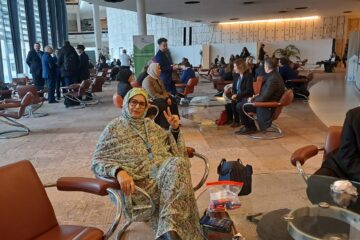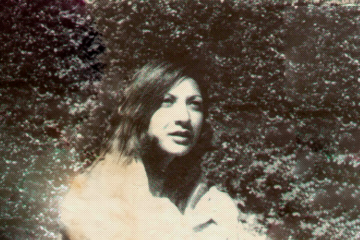If twentieth century China was a century of revolutions, then legendary Chinese writer Ding Ling was forged out of those revolutions. On 12 October 1904, Ding Ling (née Jiang Bingzhi) was born into a gentry family in Linli, in the Hunan province during the late Qing Dynasty. Her relatively prosperous background meant that she was able to attend school, and it was there that she began her politicization. At the Hunan Second Normal School for Girls, she came into contact with the anti-imperialism and national awakening of the May Fourth Movement. Later in Shanghai, she attended a People’s Girls’ School run by the young Communist Party of China (CPC), which had been formed a year earlier in 1921.
In the 1920s, Ding Ling, surrounded by communist writers such as Qu Qiubai, began her literary career. She published Miss Sophie’s Diary in 1928, one of her most celebrated works. This short story provided a provocative and rare glimpse into the internal world of a modern urban woman in China, focusing on her personal struggles, romantic affairs, and sexual desires. At the time, many writers of the New Culture Movement looked towards Western social and political frameworks to chart a path of liberation for the Chinese nation from the clutches of imperialism and economic backwardness. National liberation was also intimately intertwined with the liberation of Chinese women. Sophie, in pursuing her individual liberties, represented a break from the patriarchal and feudal family traditions of Old China, but was far from the liberated woman envisioned in socialist New China.
Each historical period demands its own kind of protagonists, and its own kind of writers. Ding Ling was one of those writers who continued to reinvent herself, while confronting the challenges. Looking back at her character Sophie two decades later, Ding Ling recognized that with the fundamental changes in the revolutionary process, “the spiritual world of the people had also fundamentally changed” and characters that she was familiar with, like Sophie, had already become outdated. It was necessary to “write entirely new people.” How to write these new people, and how to write them well was not a straightforward path.
In the early 1930s, she had become a prominent leftist writer and dove into politics, but these were dark years both politically and personally. In 1930, Hu Yepin, her husband and fellow writer, was arrested and killed—the same year that their son was born. In 1931, Ding Ling herself was arrested and detained for over two years by the Nationalists. Nevertheless, she joined the CPC and took on the task of editing the League of Left-Wing Writers’s magazine. In November 1936, after the historic Long March that established a new communist base in Yan’an, Ding Ling arrived in northern Shaanxi and asked, directly to Mao Zedong, to join the Red Army.
In January 1937, Ding Ling arrived in Yan’an, among the estimated 40,000 intellectuals who went there by 1943. Many of these intellectuals left relative urban comforts to traverse hundreds or thousands of kilometers in wind, sand, rain, and snow. Each one of these intellectuals, however, also brought their own ideas about the direction of creative work for the communist cause. Ding Ling, as the editor of the Party paper, Liberation Daily, was amongst a group of writers who criticized the perceived lack of artistic independence and restrictions set by the Party on artistic production. Was the role of art and literature to “praise the bright”—to glorify the deeds of the Party and the people—or to “expose the dark” and point to the problems in Chinese society and the communist movement?
In May 1942, the three-week Yan’an Forum on Literature and Art set to clarify this fundamental relationship between cultural and political work. To a crowd of over 100 of the country’s top writers, artists, Party leaders, and military generals, Mao laid out five artistic and literary ‘problems’ to be addressed: position, attitude, audience, work, and study. Mao argued that cultural workers should take a “class stand”, one that is firmly positioned alongside the people, in which artists also see themselves as workers in the struggle. For this, intellectuals need to go through their own “remolding” from one class to another. Meanwhile, the form and content of cultural works also had to go through a process of reinvention.
Just as traditional forms of culture were given new revolutionary content, the “old bottles” of traditional intellectuals were being transformed into “new” intellectuals who served the people. Few writers embodied this process more than Ding Ling. When Ding Ling left cosmopolitan Shanghai for the dusty fields of Yan’an, she was already an established and celebrated writer. Upon arriving in Yan’an, however, she struggled to write authentic descriptions of peasant life, which she was still unfamiliar with at the time, and to overcome her own prejudices, individualism, and alienation from the people.
In her own reflections, she said, “I’ve thought about it a lot, but it’s really difficult to write. I can’t portray people’s ideals as too high, so high that they no longer resemble a peasant farmer. But I also can’t depict them as too low; otherwise, how could they inspire people?” The difficulties that Ding and other writers had in portraying peasants in the context of class struggle was not based on their shortcomings alone, but also because the historical conditions had not yet created a revolutionary consciousness and the literacy levels among the people. Ding Ling’s short stories and novels are a testament to this transformative and dialectical process, and to the years of unlearning and relearning, to become intellectually and politically integrated with the masses, which in turn deepens class consciousness.
The path traversed by Ding Ling reflects the process of popular “integration” that Mao identified in Talks: “Intellectuals who want to integrate themselves with the masses, who want to serve the masses, must go through a process in which they and the masses come to know each other well.” After years of living and working with women, peasants, workers, veterans, and cadres in some of the country’s most remote rural districts, she wrote her first and highly-celebrated novel about land reform, entitled The Sun Shines over the Sanggan River (1948).
The founding of the PRC marked a new era in Ding Ling’s life, as writer and as political cadre. Literature, and in particular, “new people’s literature” took on a central role in the construction of the new people’s state. On an international level, literary and cultural exchange became central in the strategy of “people’s diplomacy” to overcome the diplomatic and economic sanctions placed on the new communist country. In her role as the vice-president of the Chinese Writers Association, Ding Ling often received international writers on their visits, with Jorge Amado and his wife and writer Zélia Gattai amongst them.
Their first trip in 1952 convinced Amado to republish Sun Shines in Brazil upon their return. In her memoirs, Gattai recalls, “From this joyful and fruitful trip, we and our comrades returned with light hearts and full of hope. We envisioned a future of peace and prosperity for China, an example of what socialism should be, moving from theories and paper to practice and reality.”
Their second visit in 1957, accompanied by Chilean poet Pablo Neruda and his wife Matilde Urrutia, occurred on the eve of the anti-rightist struggle, and Ding Ling was amongst the most well-known authors to be labeled rightist counterrevolutionaries. In his memoirs, Navegação de cabotagem (“Coasting”), Amado describes his exchange with Ding Ling: “When I told her about the doubts that were crushing my heart, she replied: Do you doubt just because you see injustices or mistakes? Ding Ling did not doubt. Or did she not admit to doubting? She said to me: If I step in the mud, I clean my feet and continue onwards.”
Like many intellectuals, Ding Ling indeed suffered greatly during the tumultuous decade of the Cultural Revolution (1966-1976). She was sent to the countryside, cut off from their literary work and international exchanges. However, Ding Ling eventually did find her way to “clean her feet and continue onwards.” A year after being rehabilitated in 1979, Ding said, “It was hard, and I suffered, but I also gained a lot… I can’t write about generals because I don’t have that kind of experience. But I can write about peasants, about workers, about ordinary people, for I know them well.”
The tumultuous twentieth century tells many stories; it is a story of awakening and resistance, of suffering and setbacks, and of personal transformation and political commitment. It is a story of overcoming and change. Ding Ling’s life and work is a testament to all of that. As a society was being radically transformed, the changes in the relations of production required a change in consciousness, which in turn necessitated a new socialist culture. This task was tall, the transformations were many and complex, but Ding Ling continued to carry on the task of trying to produce a new literature for, by, and in the name of the people. In a speech in 1980, she said, “Creation itself is a political action, and a writer is a politicized person,” affirming her continued commitment as a writer and as a revolutionary till the end of her life. She passed away in Beijing in 1986 at the age of 81 years.
Tings Chak is the art director of Tricontinental: Institute for Social Research, co-editor of Wenhua Zongheng: A Journal of Contemporary Chinese Thought, and a PhD candidate at Tsinghua University in Beijing.




